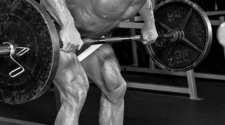Bent-Over Barbell Rows & T-Bar Rowing Exercises - Proper Exercise Form

With Proper Exercise Execution you Will Maximize your Gains
Most people doing bent-over barbell rows or T-bar rows incorrectly are almost always guilty of using too much weight and of not
positioning their body properly to isolate the lats as they row the bar. If you have to heave the bar up with your arms or with
a lot of "snap;' the weight is not being rowed. You're just pulling with your arms. If you have to drop your chest to meet the
bar, again you're not rowing the bar, you're just moving yourself and the weight around.
Whenever you do bent-over and T-bar rows you must keep your torso down and over the bar. You row the bar to your torso (lower
chest or abs), you do not drop your torso to the bar. A good mental image to have whenever performing bent-over and T-bar rows
is to imagine a jet coming in for a landing. When a jet comes in to land it is parallel to the ground? No, the nose is up and
the tail is down so the jet is tilted on an angle. Also the flaps are up, and the wheels are down. This way the jet can ride in
on a cushion of air and land properly.
As you get into position to perform rows, imagine your body is like a jet. Your glutes are low, and your head is up. Your back
is rigid and your lower back is arched, not rounded over. Your knees are flexed and you are bent- over at the waist so your
torso is a little bit above parallel to the floor at about a 45-degree angle.
The key is to keep your glutes below your hips and upper body at all times during the rowing motion. As well, always maintain the
arch in your lower back. Never, ever allow your lower back to round over because the lats cannot contract when the lower back is
rounded. As long as you keep your glutes low and your back flat, you'll have the correct tilt to the upper body. Another thing not
to do is move the bar in a straight up-and-down plane. The plane that the bar travels is slightly tilted. You pull the bar up and
in to your gut when doing barbell rows and lower the bar down and slightly away from the body on the negative. Lower all the way
down until you feel the lats stretch completely. Don't start your next rep until you've finished going all the way down with your
first.
When you pull the bar into the gut, try to pull your elbows in and back as high as possible. Try to feel the contraction in your
lats. If you have trouble keeping your body down and over the bar, the weight is too heavy. Use a weight that allows you to
mentally tie in with your lats and row correctly. A little trick to help keep the glutes low is to row while up against a wall.
Get into the proper position and jam your bull against the wall. This allows you to lever up and down against the wall using your
butt as a fulcrum. Begin with a light weight until you learn how to do the movement for maximum lat isolation and stimulation.
When T-bar rowing, use all the same body positions that you would use when barbell rowing, but stay down over the weight so the
plates hit you in the upper abs-lower chest. Do not stand up with the weight. Lower all the way down and row the plates into your
body. Keep your butt down and your torso over the weight. Then you'll use lats, not legs, arms, and shoulders.
A final word. If you cannot feel your lats as you do your rows, you're not using them. You're heaving with the arms, shoulders,
traps, and legs. Do everything to maximize lat isolation, feel, and stimulation. Then you'll experience that pump in the lats that
you're seeking, as well as a radical increase in lat growth.